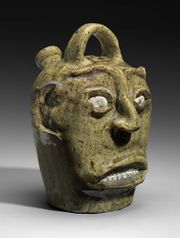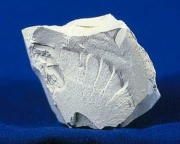Difference between revisions of "Kaolin"
| Line 1: | Line 1: | ||
| − | [[File:Thomas Davies Pottery 2011.1807.jpg|thumb| | + | [[File:Thomas Davies Pottery 2011.1807.jpg|thumb|Face jug<br>MFA #: 2011.1807]] |
== Description == | == Description == | ||
Revision as of 08:22, 15 October 2020
Description
A type of [[primary clay] formed by the weathering of aluminum silicates, such as feldspars and Nepheline. When pure, kaolin is a soft, white, absorbent powder composed primarily of the mineral Kaolinite, a hydrated aluminum silicate. Impurities, such as iron oxide, silica, and other minerals, can produce yellow, red, blue, gray, or brownish color clays. Kaolin occurs at many locations around the world (France, England, Germany, China, United States, etc.). Kaolin is used to produce fine quality Porcelain and china. It is also used as a base for lake colors and as a filler in paints, pastels, papers, rubbers, cements, and epoxies. Kaolin (as brick dust) has been used as an Abrasive for polishing Gold and other metals. It is also a useful Absorbent for oils and greases and has been used commercially for cleaning fabrics, furs, and carpets.
Synonyms and Related Terms
kaolinite; China clay; Devonshire clay; Pigment White 19; CI 77005; Kaolinit (Deut.); Satinkreide (Deut.); caolín (Esp.); kaoliini (Fin.); kaolin (Fr.); blanc de Chine (Fr.); kaolinis (Gr.); caolino (It.); terra bianca (It.); bolo bianco (It.); creta Eretria (old Roman); bolus alba (old Roman); kaolien (Ned.); caulino (Port.); satinkrita (Sven.); dkar po (Tibetan); bolus alba; porcelain clay; white bole; argilla; paper clay; brick dust; fuller's earth; white bolus; white heart; pipe clay; pipeclay;
Risks
Noncombustible
ThermoFisher: SDS
Physical and Chemical Properties
Insoluble in water, cold acids or alkalis
Microscopically particles are translucent and colorless with moderate relief. Under crossed polars, particles have low birefringence.
Kaolin fluoresces a pale white.
| Composition | Al2Si2O5(OH4) |
|---|---|
| CAS | 1332-58-7 |
| Mohs Hardness | 2.0 - 2.5 |
| Density | 2.6-2.63 |
| Refractive Index | 1.558; 1.565; 1.564 |
Comparisons
Properties of Common Abrasives
Characteristics of Common White Pigments
Resources and Citations
- WebMinerals: Kaolinite
- Nicholas Eastaugh, Valentine Walsh, Tracey Chaplin, Ruth Siddall, Pigment Compendium, Elsevier Butterworth-Heinemann, Oxford, 2004
- R. J. Gettens, G.L. Stout, Painting Materials, A Short Encyclopaedia, Dover Publications, New York, 1966
- Ralph Mayer, A Dictionary of Art Terms and Techniques, Harper and Row Publishers, New York, 1969 (also 1945 printing)
- Matt Roberts, Don Etherington, Bookbinding and the Conservation of Books: a Dictionary of Descriptive Terminology, U.S. Government Printing Office, Washington DC, 1982
- Robert Fournier, Illustrated Dictionary of Practical Pottery, Chilton Book Company, Radnor, PA, 1992
- Encyclopedia Britannica, http://www.britannica.com Comment: "Kaolin." Accessed: 2 Sept. 2004.
- Wikipedia: http://en.wikipedia.org/wiki/Kaolin (Accessed Feb. 10, 2006)
- Reed Kay, The Painter's Guide To Studio Methods and Materials, Prentice-Hall, Inc., Englewood Cliffs, NJ, 1983
- Tom Rowland, Noel Riley, A-Z Guide to Cleaning, Conserving and Repairing Antiques, Constable and Co., Ltd., London, 1981
- Jack Odgen, Jewellery of the Ancient World, Rizzoli International Publications Inc., New York City, 1982
- Richard S. Lewis, Hawley's Condensed Chemical Dictionary, Van Nostrand Reinhold, New York, 10th ed., 1993
- Van Nostrand's Scientific Encyclopedia, Douglas M. Considine (ed.), Van Nostrand Reinhold, New York, 1976
- Random House, Webster's Encyclopedic Unabridged Dictionary of the English Language, Grammercy Book, New York, 1997
- The Merck Index, Martha Windholz (ed.), Merck Research Labs, Rahway NJ, 10th edition, 1983 Comment: entry #5294
- Art and Architecture Thesaurus Online, http://www.getty.edu/research/tools/vocabulary/aat/, J. Paul Getty Trust, Los Angeles, 2000

